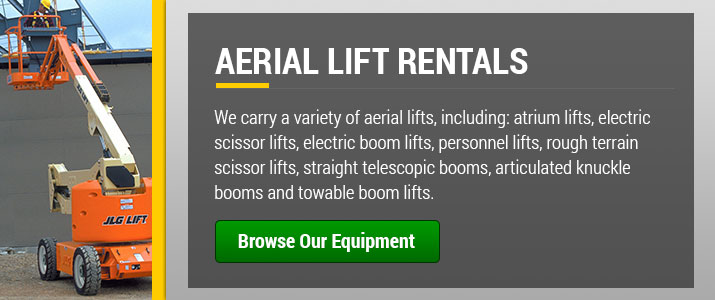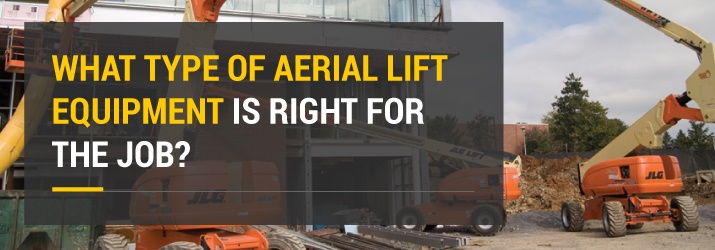
Aerial lifts are versatile pieces of equipment featuring extendable platforms that allow you to access higher work areas, such as ceilings, roofs, windows and HVAC equipment. Lift prices tend to vary greatly due to the wide variety of specialized features and options available. Deciding on the right lift for your job can be complicated, but MacAllister Rentals is here to help. Read on to learn about the various types of lifts available and advice on which type is best suited for your next job.
Renting a boom or aerial lift equipment can make your job significantly easier. Whether you need an elevated work platform or the ability to reach a tall workspace, there’s an aerial lift that’s designed for the job. But getting the right aerial lift for your needs can be tricky.
Jump to Section:
What is the job site like? How high will you need to reach? How much weight does the aerial lift need to carry? All of these questions can affect your choice of a lift. If you need an elevated workspace that can hold multiple people, a scissor lift is the best choice. And if you need a boom for horizontal jobs, an articulated boom is the lift you’re looking for.
Already know which type of lift you need? Click open the style below to view available options:
If you’re familiar with aerial lift rentals, finding the right aerial lift for rent is usually easy. But if this is your first time renting an aerial lift, or if you just rent them periodically, you may need help finding the best aerial lift equipment for your project. We’ve put together this guide to aerial lifts and what jobs they’re best suited for to help you out. Read on to find out more about what kind of aerial lift is right for the job.
What Are Aerial Lifts?
Aerial lifts feature a platform supported by a “boom,” or a tall, extendable arm used to lift the platform to a greater height. You may also know them as boom lifts, cherry pickers or bucket lifts. Aerial lift rentals are seen on many commercial construction and residential projects, and they come in many sizes and forms.

Some are designed for a specific use, such as atrium lifts. Others are meant solely for elevating a single person with a limited number of tools, and some are built for rough terrain and outside weather. In any case, aerial lifts are flexible pieces of equipment that are a necessity on many modern jobsites.
Some aerial lifts may require specific certifications or qualifications to operate. These requirements depend on your specific job and how the lift will be used.
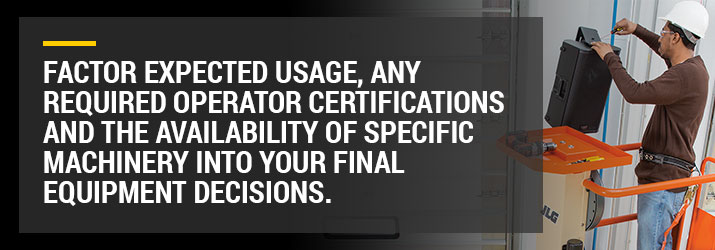
The necessary certification and training courses may be available at your local college or technical school. Be sure to consider expected usage, any required operator certifications and the availability of specific lifts when making your final rental decision.
Industries That Use Aerial Lifts
Aerial lifts are not specific to one particular industry or job. For instance, manufacturing companies use aerial lifts to reach overhead components, as well as to reach behind large pieces of equipment. General contractors use lifts to reach high areas when making repairs, and construction companies identify aerial lifts as one of the most critical pieces of equipment in their fleet.
Emergency crews use aerial lifts to reach buildings, and HVAC contractors use them for indoor and outdoor applications. In essence, aerial lifts provide reliable access for a range of industries and purposes.
Aerial Lifts Using Alternative Fuel Systems
MacAllister Rentals offers aerial lifts that are diesel, gas, liquid propane and battery-powered. Depending on the size and strength of the aerial lift you are considering, some are offered with different power options.
Articulating and straight telescopic boom lifts with a platform height of less than 80 feet are generally available with dual fuel systems that use gas and propane. These lifts, including Skyjack’s rough terrain scissor lifts, are a great option for alternative fuel on the jobsite.
The important thing to remember with lifts that are fueled by diesel or gas is that they emit carbon monoxide. These lifts will need to be used in well-ventilated indoor areas or outside.
Some lifts are available in push-around models. Push-around lifts are useful for indoor jobs that are clear of obstacles and debris. These devices are light enough to be pushed by hand, yet sturdy enough to support the weight of a worker and a limited set of tools. Such lifts are available with a variety of platform heights, working heights and ground dimensions. The most common models feature a working height of 30 or 40 feet, and a total stowed height of less than seven feet.
Push-around models usually aren’t the best choice for outdoor jobsites. The exterior terrain makes the manual movement difficult and can present serious safety hazards. Their relatively light frame means they’re easily damaged by high winds, flying debris and other obstacles.
Types of Aerial Lifts
Some types of aerial lift rentals you can consider for your project include:
- Electric Scissor Lifts: Scissor lifts move up and down, offering more capabilities than standard scaffolding. Their wide variety of platform and working heights give you more flexibility on the job.
- Rough Terrain Scissor Lifts: Similar to standard scissor lifts, rough terrain scissor lifts have been outfitted to withstand outside terrain and harsh environmental elements.
- Personnel Lifts: A personnel lift is best suited for jobs that will be completed by one person. With working heights that range from 17 to 26 feet, these are ideal for a variety of indoor projects.
- Electric Boom Lifts: Boom lifts are a type of aerial lift with a platform that can move beyond the base of the lift itself, horizontally and vertically. The boom has a considerable reach advantage and greater versatility than many other aerial lift options.
- Straight Telescopic Booms: Straight telescopic boom lifts are a great option for outdoor use. This lift lets you access hard-to-reach areas and elevated locations that aren’t suitable for scaffolding.
- Articulated Knuckle Booms: Articulated boom lifts provide even greater versatility than straight telescopic booms. These lifts are typically used in crowded outdoor environments where there are hazards and obstacles to avoid.
- Towable Boom Lifts: The ability to tow a lift behind your average work truck makes it easy to transport between jobsites and to secure it overnight.
- Atrium Lifts: The atrium lift can fold into a compact size to squeeze through a doorway. The lift then opens to reach high locations with ease. An atrium lift is best suited for a job that requires precise vertical movement.
Scroll down to learn more about each type of lift.
Scissor Lifts
Scissor lifts are a vertical lift with a platform that’s the same size as the base. They’re used in both indoor and outdoor projects, and are popular because they easily lift both personnel and equipment. Smaller scissor lifts are often used indoors, in parking garages and in urban areas. Larger, rough terrain lifts are used as aerial work platforms in a variety of settings.
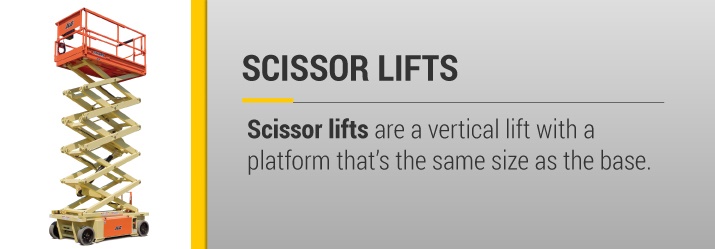
Because of their stability and relatively large platform, scissor lifts are usually used as a work platform. Unlike boom lifts, scissor lifts go in only one direction: straight up. You’ll need to be able to position the base directly beneath the area you plan to work with.
Depending on the model, expect a scissor lift to extend from ten to sixty feet. However, most scissor lifts have working heights that range from 20 to 40 feet. Scissor lifts tend to have less vertical elevation than other types of aerial lifts.
Despite the lower vertical elevation, scissor lifts do carry more weight than most other types of aerial lifts. Many scissor lifts have an unrestricted weight capacity of approximately 1,000 pounds, and higher restricted weight capacities. The largest, most powerful scissor lifts can hold up to 50 tons of material. These are usually rough terrain hydraulic scissor lifts used in heavy construction.
Electric Scissor Lifts
Best for:
- Indoor use
- Small spaces
- Multiple personnel
- Narrow areas like warehouses
Height: 10 feet to 60 feet
Workspace size: 2 feet to 10 feet wide
Electric scissor lifts are often used as an indoor aerial work platform. Unlike gas-powered lifts, electric or battery-operated lifts don’t emit fumes. This makes them healthier for workers and safer for use indoors.
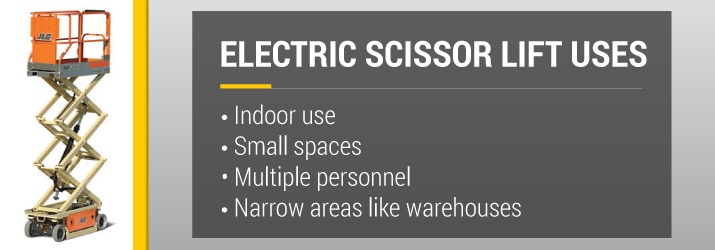
Many indoor electric scissor lifts have a narrow platform that lets workers access tight spaces in warehouses. It’s not uncommon to see scissor lifts with a work platform that’s two to three times as long as it is wide. If you’re looking for an electric scissor lift for indoor use, look specifically for one with non-marking tires. This will prevent damage to indoor floors.
Indoor electric scissor lifts are usually less expensive than larger, outdoor lifts. However, purchasing an indoor lift can cost $24,000 or more. Because of this hefty price tag, it’s more common to rent scissor lifts only when they’re needed. If you need a scissor lift for a longer-term project, it’s also possible to rent them by the week or month.
Rough Terrain Scissor Lifts
Best for:
- Aerial work platform
- Multiple personnel
- Outdoor use
- Uneven surfaces like ungraded construction sites
Height: Up to 60 feet
Workspace size: 2 feet to 10 feet
Rough terrain scissor lifts are aerial work platforms designed specifically for outdoor use and uneven surfaces. These exterior scissor lifts are usually powered by a diesel engine. Unlike electric models, these diesel-powered models can emit significant fumes.
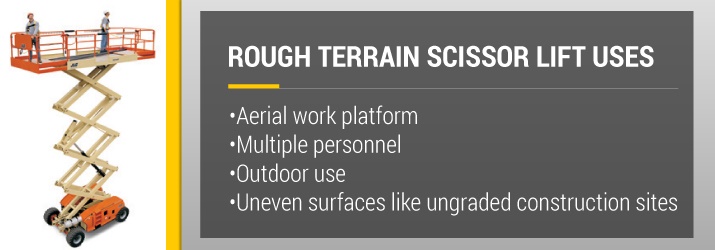
Rough terrain scissor lifts usually have four-wheel drive and reinforced tires. This makes it possible to use them on a variety of different surfaces. However, these tires can leave marks, so they’re not suitable for use on finished floors.
Some rough terrain scissor lifts can be driven and used on slopes. If you know that you’ll have an uneven construction surface, look for one of these models. The ability to operate on sloped surfaces is called gradeability, and usually ranges from 0 to 40 percent.
Rough terrain scissor lifts have work platforms just like the indoor models. However, outdoor scissor lifts usually provide more workspace than the indoor models. Expect work platforms that are from two to four feet wide, and from five to ten feet long. Larger platforms will provide more accessibility for multiple workers.
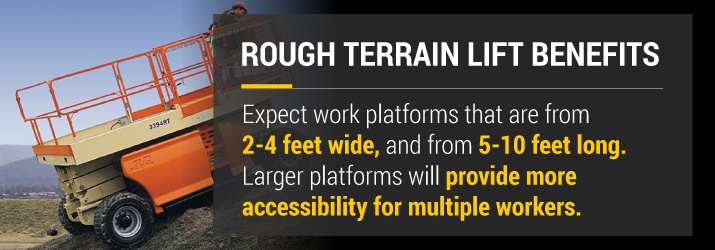
Exterior scissor lifts usually have a higher weight capacity than indoor models. If you expect to have multiple personnel on the platform, or will need to lift construction materials, look for a scissor lift with a higher weight capacity.
Rough terrain scissor lifts are usually more expensive to purchase or rent than indoor models.
Boom Lifts
Boom lifts are a remarkably versatile type of aerial lift. All varieties of these lifts have a base, a maneuverable arm and a work platform or attachment on the end of the arm. That’s where the similarities end, though.
The major differences between types of boom lifts can be divided into three major categories:
- Boom type
- Bucket/workspace attachments
- Power source
The most popular types of boom lifts have vertical, knuckle or telescoping booms. The type of boom affects how high the workspace can be extended, whether it can be angled or simply lifted up and down, and the amount of weight that the boom lift can hold.
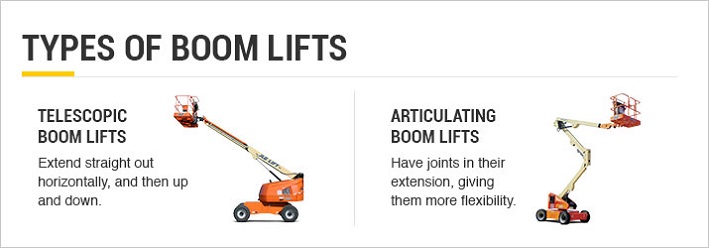
Most boom lifts have a workspace platform at the end of the boom. The size and type of this workspace is affected by the maximum weight that the boom can hold. However, boom lifts can be outfitted with a variety of different attachments. Lifting hooks, lumber forks and buckets are all common alternatives.
The third major difference between boom types is the power source. Aerial booms can be electric, battery-operated or diesel-powered. There are also towable aerial booms, which are pulled by a truck or van.
Electric Boom Lifts
Best for:
- Confined spaces
- Aerial work platform
- Workspaces where you’ll need to move from side to side
- Lifting one worker
- Jobs that require multiple attachments
Height: 30 feet to 100+ feet, depending on model
Workspace size: Base ranges from 3 feet to 10 feet wide; Work platform varies more widely
Electric boom lifts are smaller lifts designed for use in confined spaces. They have an electric or combined electric/battery power source. Because they don’t emit fumes, they’re suitable for use in confined spaces. They’re also a more environmentally friendly option than diesel engines.
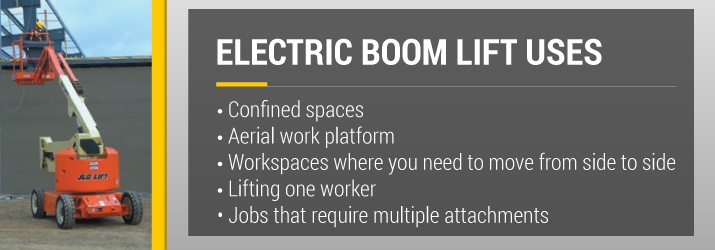
Expect these lifts to be somewhat smaller than other models. Despite the more compact size, they have serious lifting power. Platforms or buckets usually extend at least 30 feet in the air. It’s common to find models that extend up to 60 feet, but most models have working heights of 30 to 40 feet.
Electric lifts can have a variety of boom types. Mast booms, which extend vertically, are a common option for work platforms. These aerial booms lift a workspace straight up and down. Articulated booms have Z-type booms that allow you to move the workspace from side to side without needing to move the base. These electric boom lifts are often equipped with non-marking tires, so they can be used on a variety of work surfaces — including indoors.
Look for electric boom lifts equipped with Jib, JibPlus or similar handling technology if you’ll need to maneuver in small spaces. This type of technology allows you to maneuver the work platform 180 degrees, making it easier to access areas behind equipment. We carry a number of JLG boom lifts equipped with this technology.
Finally, telescoping booms provide maximum reach. These are used in very high areas where there’s limited access. They’re common in both utility and construction industries. Some of the boom manufacturers we carry, like Genie, offer telescoping booms that extend more than 100 feet. Look for electric-powered telescoping booms for a sustainable alternative to diesel-powered ones.
Towable Boom Lifts
Best for:
- Jobs where portability is important
- Outdoor decorating
Height: From 10 to 60 feet, depending on model
Size: Usually 4 to 6 feet wide
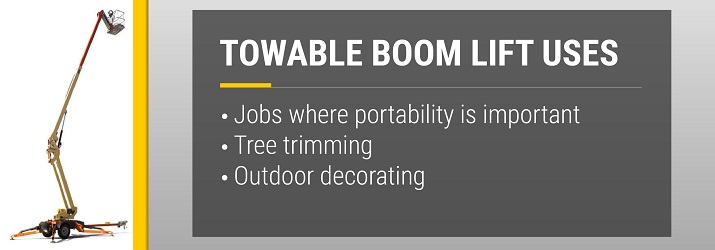
Towable boom lifts are an ultra-portable option, and that makes them ideal for jobs that require lots of movement. These lifts can be attached to a truck or van and pulled to different jobsites. They’re often used for outdoor projects where portability is important, like outdoor decorating or utility work. Towable boom lifts are sometimes used in place of cherry pickers, since they serve similar functions.
Towable boom lifts may have diesel engines, or they may be electric. Since the engine is used primarily to control the boom, it’s relatively low-powered compared to a self-propelled aerial boom. However, electric booms are still a better choice for indoor use, since they don’t emit fumes.
Our towable lifts are manufactured by Genie or JLG. These lifts have a compact base with an articulated boom. Many towable lifts have a hydraulic worker’s platform, and some include outriggers for extra stability. If you need to move a lift regularly, look for a model that sets up quickly, like Genie’s Drive and Set options.
There’s a high demand for towable booms, which can drive both rental and purchase costs up. Another big influence on price is the maximum height of the lift. Purchasing a Genie towable boom with a 65-foot maximum reach can run upwards of $100K, but rental rates can be much more competitive.
Articulated Knuckle Booms
Best for:
- Hard-to-reach areas like behind equipment
- Up-and-over workspaces
- Wide work areas that require extra reach
Height: Up to 125 feet
Width: Usually 3 to 8 feet wide
Articulated knuckle booms are Z-style aerial lifts that provide maximum flexibility. They’re usually compared to telescoping, stick or straight booms. These booms provide both vertical and horizontal flexibility, which makes them useful in a wide variety of job sites.
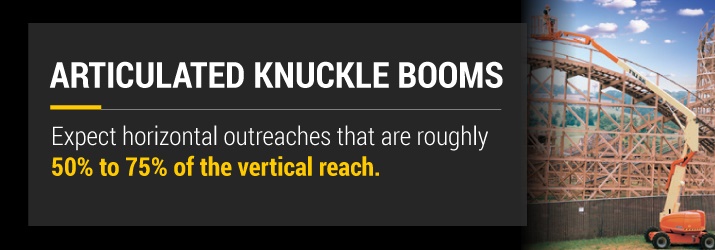
These aerial lifts were designed to access hard-to-reach worksites. The boom can be extended in sections, allowing workers to maneuver up and over obstacles. They’re popular for work on utility lines and similar situations.
Be aware that the horizontal reach of most articulated booms is significantly less than the vertical reach. Expect horizontal outreaches that are roughly 50 to 75 percent of the vertical reach. For instance, JLG’s 800 series of articulated boom lifts has horizontal outreaches of approximately 50 feet. If you need more horizontal reach but want an articulated knuckle boom, consider a model with an S-boom instead of a Z-boom. These models are specifically designed to provide additional horizontal reach while maintaining the stability of other models.
Like telescoping booms, articulated knuckle booms are available for both indoor and outdoor use. Indoor models are usually smaller and narrower than outdoor models. For indoor use, look for an articulated boom with an electric power source and non-marking tires. For outdoor use, look for a diesel-powered or towable articulated boom. If you expect to work on rough terrain, consider an articulated knuckle boom with rough terrain tires or treads.
Straight Telescopic Boom Lifts
Best for:
- Extremely high workspaces
- Workspaces with minimal horizontal movement
Height: Up to 185 feet
Workspace size: 8+ feet wide
Straight booms, or telescoping booms, are the most common alternative to articulated booms. They’re sometimes also called “stick booms,” because they have an arm that moves in a single direction. Since these lifts have a single boom, they’re a little easier to operate than an articulated boom.
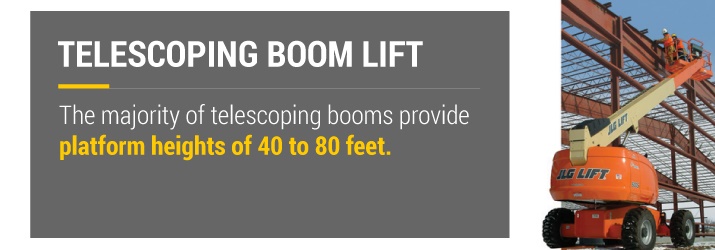
Telescoping booms are used to provide maximum elevation. They’re most commonly used in industrial construction projects, where workers regularly need to reach very high areas. The majority of telescoping booms provide platform heights of 40 to 80 feet. Some models provide significantly more. The Genie S-180 has a platform height of 180 feet, while JLG’s 1850SJ offers reaches of up to 185 feet.
To support platforms at these heights, telescoping booms tend to have a much wider base than other types of aerial lifts. Your job site will need to accommodate widths of eight to 10 feet. Rough terrain telescoping booms usually have outriggers for stabilization, which require a bigger work surface.
Expect to see similar rental and purchase prices for telescoping and articulated booms. The prices of both types of lifts are determined primarily by the reach of the machine and its power source. Expect higher prices for booms with more reach, as well as for booms with a diesel power source. Towable telescoping booms are also in high demand.
Atrium Lifts
Best for:
- Narrow workspaces
- Areas where weight capacity is a concern
- Extremely high reach
Height: Up to 60 feet
Size: Approximately 3 feet wide; Lengths up to 20 feet
Atrium lifts are a special type of articulated knuckle boom. These extremely narrow, lightweight lifts are ideal for achieving maximum elevation in a small area. They get their name from their popularity indoors, but are used in a wide variety of indoor and urban projects where space is at a premium.
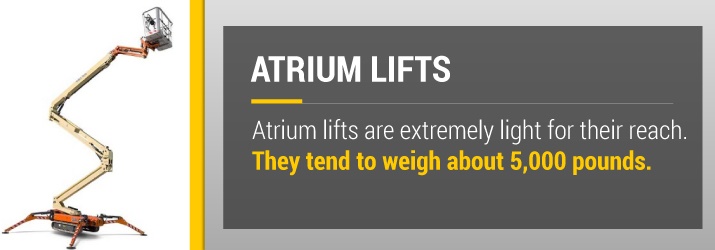
Atrium lifts are extremely light for their reach. They tend to weigh about 5,000 pounds, which makes it possible to use them on second stories or in areas where there are weight concerns.
Most atrium lifts have a Z- or S-type articulated knuckle boom. Expect vertical reaches of 50 to 70 feet, and horizontal outreaches of up to 40 feet. The articulated boom means that the personnel bucket reaches a full 360 degrees.
Because of their very narrow base, most atrium lifts have outriggers to stabilize the base. This means that the actual footprint of the lift while it’s in use is much bigger than the stowed width. However, the narrow stowed width will allow you to navigate an atrium lift through a standard door before setting it up. If you’re considering renting an atrium lift, make sure that the project area can accommodate these outriggers.
Personnel Lifts
Best for:
- Indoor use
- Compact spaces
- Light construction
- Maintenance
Height: 15 to 50 feet
Size: 2 to 3 feet wide
Personnel lifts are extremely compact aerial lifts that are usually used indoors. They’re also called man lifts, one man lifts or push-around lifts. Sometimes, man lifts are used interchangeably with atrium lifts.
These lifts are most useful when space is at a premium. Personnel lifts tend to be just two to three feet wide, and are rarely longer than five feet. Some models have outriggers for stabilization, which extend the footprint of the base just slightly. When stored, these lifts are just five to six feet high.
Personnel lifts have a significantly lower weight limit than most other types of aerial lifts. Expect unrestricted weight limits of just 200 to 400 pounds, which makes them most suitable for lifting a single person. The lift itself is also much lighter than other aerial lifts, with JLG’s extremely lightweight AWP25DC weighing just 727 pounds.
Man lifts are used primarily for indoor construction, renovation and maintenance projects. When used for ongoing tasks like maintenance, it’s more common for an organization to purchase the man lift than it is to rent it. For one-time projects like construction and renovation, rental can be a more affordable choice.
Man lift rentals make it possible to choose from a variety of power sources and terrain styles. Electric lifts are usually slightly heavier, and are used for a variety of indoor projects. Push-around single man aerial lifts are lighter than their electric counterparts. They usually require outriggers for stabilization, but are easy to maneuver around tight corners.
Understanding Your Options and Choosing the Right Aerial Lift Rental for Your Project
It’s important to be aware of the different lift options available so you can pick the best lift for your upcoming project.
Our aerial lift guide will help you navigate the world of aerial lifts. You’ll understand more about the different uses of each lift and how to rent lift equipment. You’ll also learn about the many heavy-duty lift options that are on the market today.
Once you’ve found the lift you need, or if you want to review the features of each lift, contact MacAllister Rentals. We can help determine if that lift is best for your project needs.
Ready to rent an aerial lift? View our full range of lifts online, or call us (877) 700-1945 for more help choosing an aerial lift.
